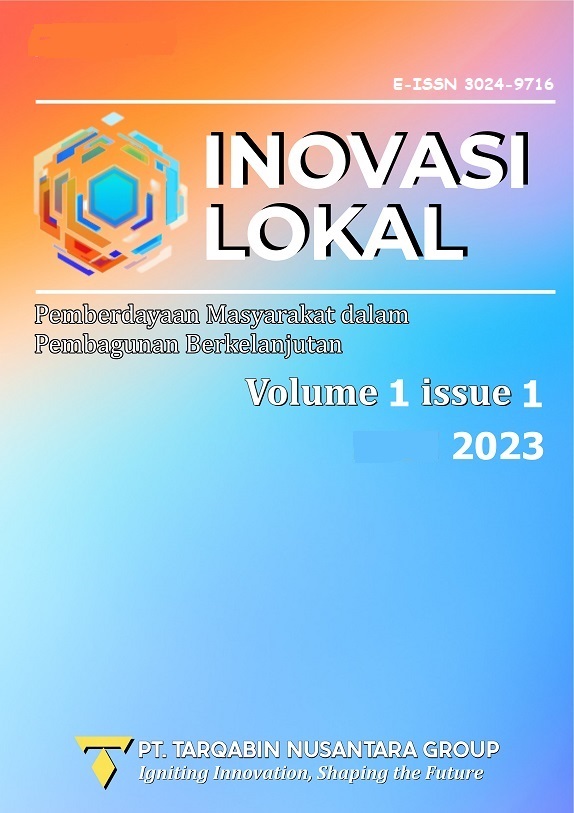Mood Box: As a Form of Recognizing the Mental Emotions of Kedung Padaringan 2 Elementary School Students as the First Step Towards a Healthy and Comfortable School
DOI:
https://doi.org/10.62255/noval.v1i1.18Abstract
Basic education is an important aspect in a country's development. The comfort of children's learning in
elementary schools (SD) has a crucial role in determining the quality of their education. Children's
emotions can affect their learning comfort, and managing children's moods from an early age is very
necessary. One effort to increase children's learning comfort at Kedung Elementary School, Kepanjen,
Malang Regency is through the implementation of the Mood Box Work Program (Proker). This program
aims to create positive learning conditions, stimulate learning motivation, and reduce the impact of stress
due to changes in learning patterns. In this journal, we will describe the Mood Box Program and the
results of its evaluation of children's learning comfort at Kedung Elementary School. We will explore
the methods, approaches and changes produced by this program in an effort to improve the quality of
learning at this school. A deeper understanding of the impact of this program can provide a better view
of the importance of a positive and comfortable learning environment for children in these challenging
times. Through analysis and reflection on the Mood Box Program, we hope to make a positive
contribution in efforts to improve the quality of basic education at Kedung Elementary School, as well
as provide insight for policy makers, educators and researchers in understanding the importance of
creating a learning environment that is conducive to the development of children in future.
Downloads
Keywords:
Education, Learning, Children, Mood boxReferences
Arianti. (2017). THE URGENCY OF A CONDUCIVE LEARNING ENVIRONMENT IN ENCOURAGING STUDENTS TO ACTIVE LEARNING. Education, 11(1).
Sholihah, A., & Kurniawan, RY (2016). Analysis of the influence of learning motivation and learning environment on learning outcomes. Journal of Economic Education (JUPE), 4(3).
Umaroh, R. (2021). IMPROVING THE GOOD MOOD OF EARLY CHILDREN WITH PLAYING AND SINGING METHODS AT RAM NU 140 PARINGAN II JENANGAN. Thesis.
Khoerani, Iin (2018). Penerapan Enterprise Resources Planning Modul Warehouse Management dan Quality (PT. Equilab International. Jakarta: Universitas Pancasila.
Mahfiza. (2020). Penerapan Teknologi Enterprise Resource Planning (ERP) Dalam Meningkatkan Kualitas Sistem Informasi Manajemen Al-Buhuts e-Jurnal,16(1),157-16 https://doi.org/https://doi.org/10.30603/ab.v16i1.1762
Meizana, Muhammad Zakky, Rispianda dan Khuria Amalia (2016). Rancangan Enterprise Resource Planning di Jedugmilk dengan Menggunakan Openbravo. Bandung: Institut Teknologi Nasional
Nani Agustina.2018. Evaluasi Penggunaan Sistem Informasi ERP dengan Metode Pieces Framework. JURNAL INFORMATIKA, Vol.5 No.2 September 2018, pp. 278~286. AMIK BSI Jakarta
Republik Indonesia, 2014. UUD Nomor 46 Pasal 1 Tahun 2014, tentang Sistem Informasi Kesehatan. www.kemenkopmk.go.id
Saade, R. G., & Nijher, H. (2016). Critical success factors in enterprise resource planning implementation: a review of case studies. Journal of Enterprise Information Management, 29(1), 72–96. https://doi.org/10.1108/jeim-03-2014-0028
Soliman, M., & Karia, N. (2015). Enterprise resource planning (ERP) system as an innovative technology in higher education context in Egypt. International Journal of Computing Academic Research (IJCAR), 5(4), 265-269.
Susanto Azhar.2013. Sistem Informasi Manajemen: Pendekatan Struktur Risiko Pengembangan. Edisi Perdana: Lingga Jaya. Bandung.
Taufiq, Rohmat. 2013. Sistem Informasi Manajemen. Yogyakarta: Graha Ilmu. Nasaruddin, dkk. 2013. Perancangan Sistem Informasi Supply Chain Management (SCM) pada CV Rajawali Multi Niaga Makassar. Jurnal CCIT Vol.6 No.2,226-227. Perguruan Tinggi Raharja. Tangerang
Tullah, R., & Hanafri, M. I. (2014). Evaluasi Penerapan Sistem Informasi pada Politeknik Lp3i Jakarta dengan Metode Pieces. Jurnal Sisfotek Global, 4(1), 22–28.
Downloads
Published
How to Cite
Issue
Section
License
Copyright (c) 2023 Ainin Zain Zahro, Alifian Akhsan F, Anggun Safitri, Aurelia Marsha N, Destyn Panggabean, Kresna Wicaksono, Malinda Salsabila, Nasywa Nabiilah E.R, Nur Faridatul Amla, Paksi Samudro, Rahayu Deka Fadila, Yanti Hosianna Tri Agus Sinaga, Zahrotul Fakhriyyah

This work is licensed under a Creative Commons Attribution-ShareAlike 4.0 International License.












